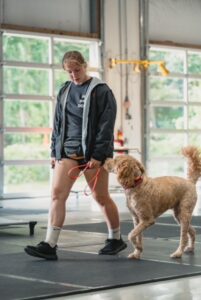It is a thrilling and joyful event to welcome a new puppy into your house. It can, however, present its own set of obstacles, especially when your furry bundle of energy appears to have an unending supply of wild antics. But don’t worry! You can quickly turn your boisterous ball of fur into a well-behaved and quiet companion with the appropriate approach and a little patience.
We will walk you through the process of taming your crazy dog in this post, providing practical advice and tried-and-true strategies to bring order to the mayhem. We will cover all you need to know to assist you in traversing this path and maintaining a happy connection with your four-legged friend, from analyzing their behavior to setting routines and adopting effective training methods to boosting mental stimulation. So get ready to go on a transformational journey with your dog to change turmoil into calmness!
The Nature of Puppy Behavior
A rambunctious puppy is such adorable pandemonium! They’re like adorable tiny balls of energy with an insatiable curiosity and a penchant for mischief. Understanding their behavior is the first step in taming the wild.
Puppies are naturally inquisitive and lively animals. They like exploring their surroundings, chewing on everything they see, and pushing their limits. So, if your shoes go missing or your furniture gets nibbled on, know that it’s simply your dog being a puppy.
How to Tame Your Wild Puppy
1. Setting Up a Structured Environment: Establishing Boundaries and Routines
- Crate Training: Creating a Safe Space
When it comes to taming the wild, creating a regulated atmosphere is essential. Crate training can be life-changing. It creates a safe and cozy environment for your puppy to unwind and enjoy some alone time. Furthermore, it helps to avoid unexpected incidents and keeps children out of trouble while you are not present to oversee.
- Designating Puppy Zones: Managing Access and Boundaries
Another strategy to handle your puppy’s wild instincts is to designate discrete puppy zones in your home. Set up baby gates or utilize playpens to create boundaries, allowing your puppy to explore certain areas but keeping them away from places they shouldn’t (like your costly shoe collection).
- Establishing Consistent Meal Times
Puppies, like humans, thrive on routine. Setting consistent meal times can help them maintain their energy levels and avoid the madness caused by hunger. When you know when to expect those “nature’s calling” moments, potty training becomes much easier.
2. Consistency is Key: Creating a Training Plan
- Basic Commands: Sit, Stay, Come
Consistency is your secret weapon when it comes to taming a wild puppy. Begin with simple directions like sit, remain, and come. These directives not only teach your puppy proper etiquette, but they also provide mental stimulation and cement your role as their valued leader.

- Leash Training: Walking on a Loose Leash
Any wild puppy must be trained to walk on a leash. No more getting pulled about on your daily walks like a ragdoll! Teach your puppy to walk on a loose leash with a Heel command, which will make the experience more enjoyable for both of you. Remember, it’s all about them getting some exercise, not you turning into a human sled.
- Potty Training: Teaching Proper Elimination Habits
The notorious toilet training adventure. It’s not the most glamorous aspect of puppy ownership, but it’s necessary. Establish a schedule, take them out frequently, and lavish them with praise as if they’ve just won a gold medal every time they do their business in the proper location. In potty training, positive reinforcement goes a long way.
3. Positive Reinforcement: Rewarding Good Behavior
- Understanding the Power of Rewards
When they behave well, lavish them with praise, treats, and belly rubs. They’ll quickly understand that, just like us, being a well-behaved pup delivers unlimited rewards.
- Using Treats and Toys Effectively
Treats and toys are your hidden weapons when it comes to teaching a rambunctious puppy. Use them strategically to reinforce positive behavior and divert attention away from unhealthy habits. However, be careful not to convert your pet into a treat junkie. When it comes to those seductive puppy dog eyes, remember that moderation is vital, both for them and for yourself.
4. Correcting Unwanted Behavior: Effective Techniques for Correction
- Preventing Jumping, Biting, and Chewing
We’ve all seen it happen: your cute little ball of fur transforms into a small whirlwind, jumping on anything in sight, biting anything that moves, and chewing on your beloved sneakers. But don’t worry, there are strategies to reroute these undesirable tendencies. Begin by teaching your puppy alternate commands like “sit” or “leave it” and rewarding them when they obey. Additionally, offering appropriate chew toys and exercising your dog regularly can help them release excess energy and reduce destructive chewing.
- Counter Surfing: Teaching Boundaries in the Kitchen
Consistency is essential in dealing with this behavior. When you can’t supervise, set clear boundaries by utilizing baby gates or sealing off the kitchen. You may also teach your puppy the “off” command and reward them for remaining on the ground. Remember that pups are naturally inquisitive, so be patient and consistent in encouraging the correct behavior. Additionally, teaching a Place command so the puppy has a specific place they need to stay while you eat.
- Discouraging Excessive Barking
Is your puppy preparing for a barking contest? Excessive barking might be aggravating, but it’s critical to understand the underlying causes. Is your dog bored, worried, or looking for attention? Once you’ve determined the root problem, you can work on redirecting their energy. Mental and physical stimulation, such as physical exercise or training sessions, might keep them focused and lessen their desire to bark. Don’t forget to thank and congratulate them when they demonstrate calm conduct.
5. Mental Stimulation: Keeping Your Puppy Engaged and Occupied
- Interactive Toys and Puzzle Games
A bored puppy is a naughty puppy. By giving engaging toys and puzzle activities, you can keep their minds sharp and their paws out of mischief. These toys test their problem-solving abilities and keep them amused while you’re at work. The possibilities are unlimited, from treat-dispensing toys to puzzles that challenge them to uncover concealed sweets. Simply oversee playtime to ensure that the toys are safe and appropriate for your puppy’s age and size.
- Training Beyond Basic Commands: Tricks and Obedience
Why not take your puppy’s training to the next level once they’ve mastered the fundamentals? Teaching them enjoyable tricks like “rollover” or “fetch” not only engages their wits but also deepens your bond with your pet. You can also try advanced obedience exercises, so they work their minds and boost confidence and coordination. Remember that training should always be enjoyable for both you and your dog.
6. Socialization and Exposure: Introducing Your Puppy to the World
- Safe and Positive Encounters with People and Other Animals
To raise a well-rounded and confident dog, socialization is crucial. Expose your puppy to a variety of people, animals, and situations from an early age. Organize playdates with other friendly and vaccinated dogs, invite friends and family over, and take them to puppy training classes. Always ensure these interactions are positive and supervised, allowing your puppy to develop social skills and build positive associations.

- Exposure to Various Environments and Stimuli
The world might be intimidating for a small puppy, so introduce them to new situations and stimuli gradually. Take them on walks through different neighborhoods, introduce them to varied sounds (think vacuum cleaners or car horns), and allow them to touch different surfaces (carpets, grass, sand). You may help children become more adaptive and confident in different situations by gradually introducing them to new experiences.
FINAL THOUGHTS
To summarize, taming a wild puppy may appear to be a difficult endeavor, but with devotion, consistency, and the proper tactics, you can modify their behavior and establish a serene and loving atmosphere. Remember to be patient, to applaud improvements, and to seek expert assistance if necessary. The transition from mayhem to quiet will take time and work, but the bond you will have with your well-behaved puppy will be well worth it. So embrace the experience, have fun with the process, and bask in the delight of having a happy, balanced, and well-behaved furry companion at your side.
Our mission is to give dogs a voice and provide owners with the knowledge they need to live the best life possible with their dogs. Join the movement!
Click Here to Subscribe to our YouTube Channel for More Videos of Dog training.
Contact us or visit Upstate Canine for more blogs.
